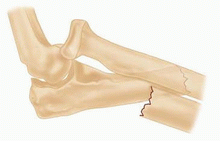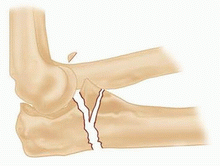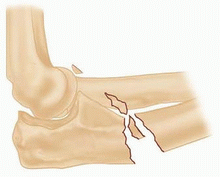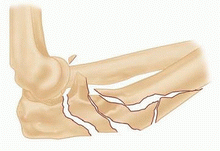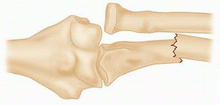Open Reduction and Internal Fixation of Monteggia Fractures in Adults
Open Reduction and Internal Fixation of Monteggia Fractures in Adults
PATHOGENESIS
The exact mechanism of injury for Monteggia fractures is controversial.
Proposed mechanisms of injury for type I injuries include the following:
Direct blow to the posterior aspect of the elbow
Fall on outstretched arm with hyperpronated hand (forearm pronation levers radial head anteriorly)
Fall on outstretched arm
Violent contraction of biceps pulling radial head anteriorly
Proposed mechanism for type II injuries: hypothesized to occur when a supination force tensions the ligaments that are stronger than bone
Proposed mechanism for type III injuries: direct blow to the inside of the elbow with or without rotation
PATIENT HISTORY AND PHYSICAL FINDINGS
IMAGING AND OTHER DIAGNOSTIC STUDIES
Plain radiographs (
FIG 1): Orthogonal radiographs of the elbow, forearm, and wrist are required.
Ulna fracture is easily identified.
Radial head fracture or dislocation can be subtle, especially if radial head dislocation reduces.
Computed tomography (CT) scans can be helpful to determine the extent of the bony injury and the location of fracture fragments. They are particularly helpful in fractures involving the coronoid, olecranon, and radial head.
3D CT reconstructions provide information on the spatial relationship of fracture fragments in comminuted fractures.
NONOPERATIVE MANAGEMENT
Monteggia fracture-dislocations in the adult population are generally treated surgically.
Improved fixation methods and surgical technique have remarkably improved the results of surgery, making it a more reliable treatment option.
SURGICAL MANAGEMENT
Preoperative Planning
The timing of surgery depends on the condition of the soft tissues and the availability of necessary equipment and personnel.
The surgeon should define all injuries that need to be addressed.
Equipment requirements:
Bone graft (allograft or autograft)
Get Clinical Tree app for offline access




